What Is Influencer Marketing?
Influencer marketing is a strategy in which businesses work with people who have large, engaged social media followings. These partnerships aim to increase brand awareness and reach new audiences.
For example, clothing brands often partner with local influencers worldwide to create sponsored posts on Instagram:

This approach pays off.
Traffic Analytics shows that the brand in the example above receives about 88,200 monthly organic visits from social media, which accounts for 12.62% of their overall site traffic.

Influencer marketing works best when brands choose influencers who share a similar audience.
In other words, you need to find influencers whose followers match your target customers.
Use this guide to find ideal influencers for your brand.
Why Finding the Right Influencers Is Essential
The main benefit of influencer partnerships is that they connect you with the right audience.
Suppose you own a small Korean restaurant in downtown Los Angeles. You want to reach Korean food fans in that area.
Collaborating with a local food vlogger who has thousands of Instagram followers can help you reach that audience.
Other benefits of working with the right influencers include:
- Increasing credibility: A trusted influencer partnering with your brand signals to potential customers that your brand is credible
- Boosting brand awareness: Influencers help you reach new potential customers
- Driving sales: When the right influencer promotes your products, you are likely to see an increase in sales
Not every influencer is a good fit, though.
For example, partnering with Kim Kardashian doesn’t make sense for a small Korean restaurant. She has a massive following, but her fees are high, and her content focuses on other topics.
Her followers probably aren’t your target market.
Other things you need to be careful of when working with influencers include:
- Fake followers and bots: Some influencers inflate follower counts with bots
- Too much sponsored content: Influencers who only post ads lose engagement over time
Working with untrustworthy influencers can damage your brand reputation and end up hurting sales.
The right influencer can help your brand grow. The wrong influencer can damage it.
Research carefully before creating partnerships.
Types of Influencers
Influencers often fall into categories based on their follower size. Below are the five main influencer types and typical costs:

1. Nano Influencers
Nano influencers have 1,000 to 5,000 followers.
They usually engage closely with their community, and their followers trust their recommendations.
For example, a travel influencer with around 5,000 followers could partner with travel brands to create highly engaging content that gets a lot of likes and comments:

Working with a nano influencer can help if:
- You aim to target a specific, small niche
- You have a limited budget (nano influencers often charge $0 to $1,000 per post)
- You want to target a certain local audience or region
2. Micro Influencers
Micro influencers have 5,000 to 30,000 followers.
They often focus on one or two topics and are often seen as niche experts.
For example, a reputable, professional freediver with about 15,000 followers could be the ideal partner for freediving gear brands.

Working with a micro influencer can help if:
- You need to work with niche experts
- You want to reach a larger audience than a nano influencer that is still highly engaged
- You’re looking for a cost-effective option (micro influencers typically charge $500 to $2,000 per post)
3. Mid-Sized Influencers
Mid-sized influencers have 30,000 to 200,000 followers.
They often have a solid reputation and experience working with brands, which can make collaboration smoother.
For example, this gaming influencer partnered with a gaming brand to host a giveaway on social media.

Working with mid-sized influencers can be beneficial for your brand if:
- You want to reach a wider audience
- You prefer influencers who have partnered with bigger brands before
- You need balanced costs and decent reach (typical rates: $1,000 to $4,000)
4. Macro Influencers
Macro influencers usually have 200,000 to 500,000 followers. They have experience creating influencer campaigns and know how to engage followers.
For example, a food influencer with 325,000 Instagram followers partners with food and kitchenware brands to create engaging content.

Work with macro influencers if:
- You have experience working with influencers and want to expand
- You can invest more in influencer marketing (often $2,000 to $6,000 per post)
- You want to reach a large audience or a new market
5. Mega Influencers
Mega influencers have over 500,000 followers.
They are often celebrities (actors, singers, sports figures) and usually work with large teams.
For example, popular YouTube influencers often collaborate with relevant brands to generate more views, which can lead to more sales.

Consider mega influencers if:
- You have significant influencer marketing experience
- You want massive, global reach
- You need a big-name endorsement
- You can invest the required time, money, and resources (rates start around $3,000 but can be much higher)
How to Find Influencers on Instagram, YouTube, and Other Platforms
Here are seven ways to find influencers you can trust to promote your brand.
1. Use Influencer Discovery Tools
Influencer discovery tools like Influencer Analytics help you find ideal influencers.
Some benefits of using tools include:
- They save time and money
- They detect fake followers or fraudulent behavior, which protects you from scams
Instead of manually searching, use Influencer Analytics to browse vetted creators in a few steps.
Go to Influencer Analytics and click on “Influencer Discovery” in the navigation menu.
Choose your platform from the drop-down menu (e.g., “YouTube”).

Open the “Filters” menu.
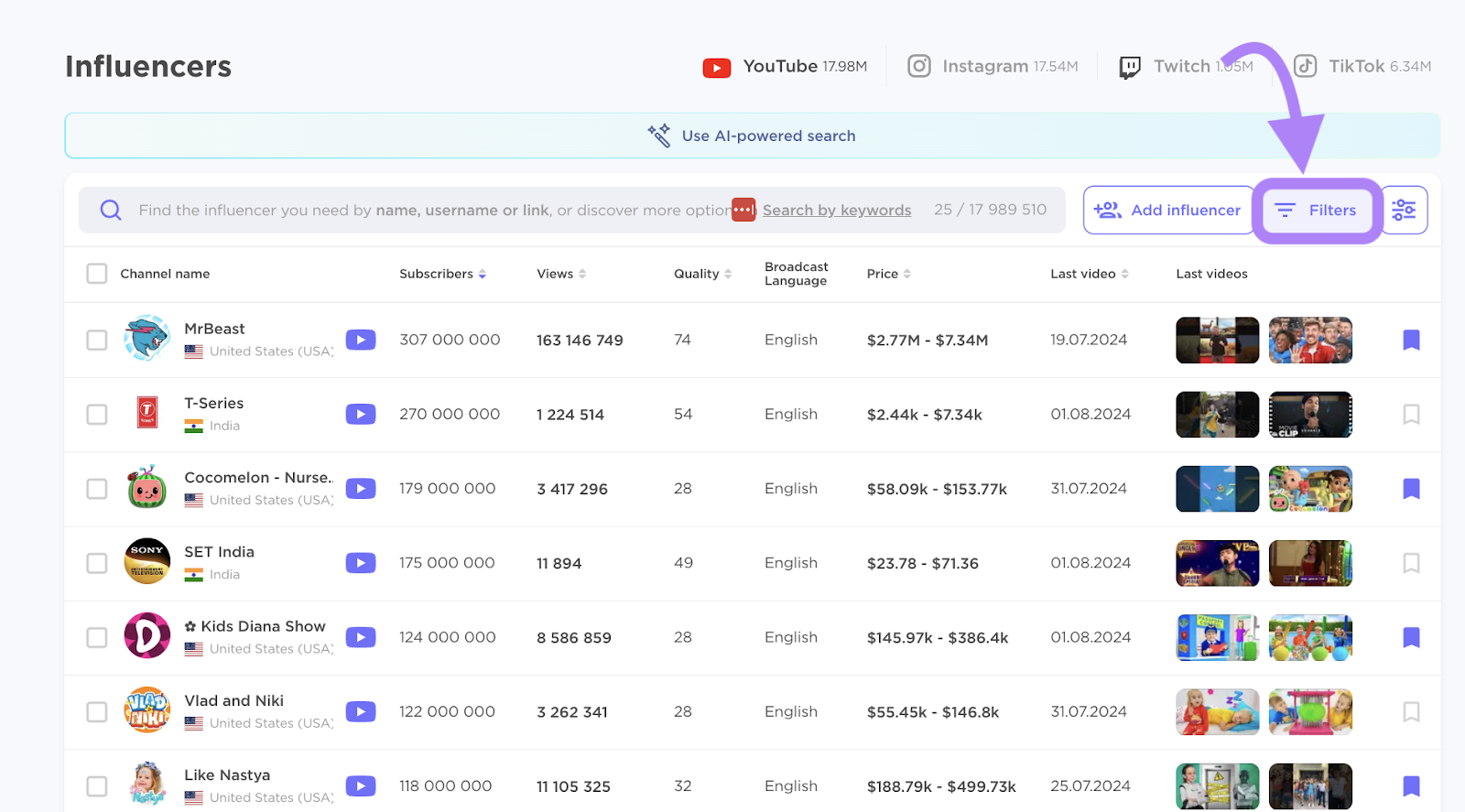
Let’s say you want a mega influencer in the automobile niche.
Once the filters open up, specify what you’re looking for to narrow down your search results.
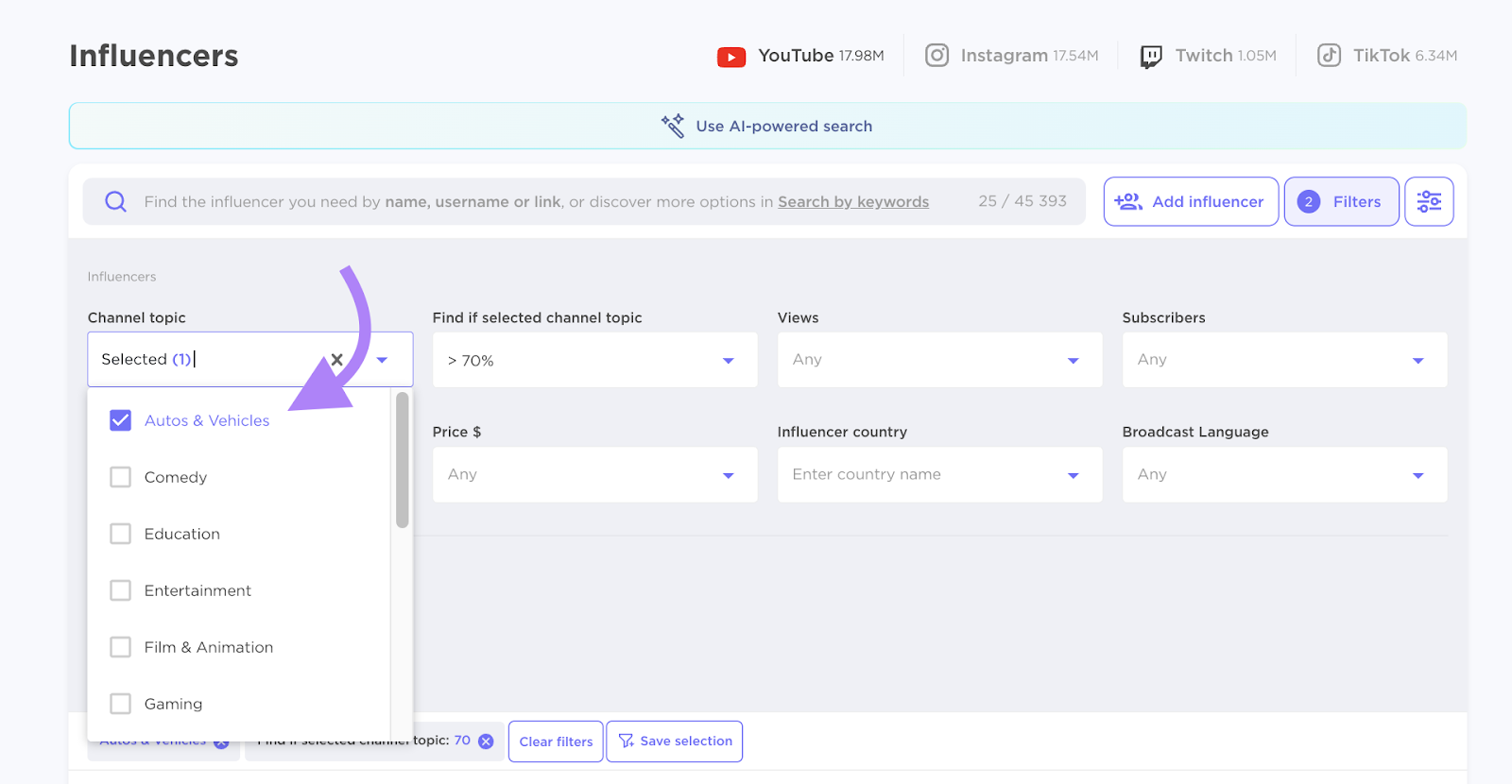
Select other filters, such as number of views, subscribers, price, country, and language. After filling out the filters, click “Save selection.”
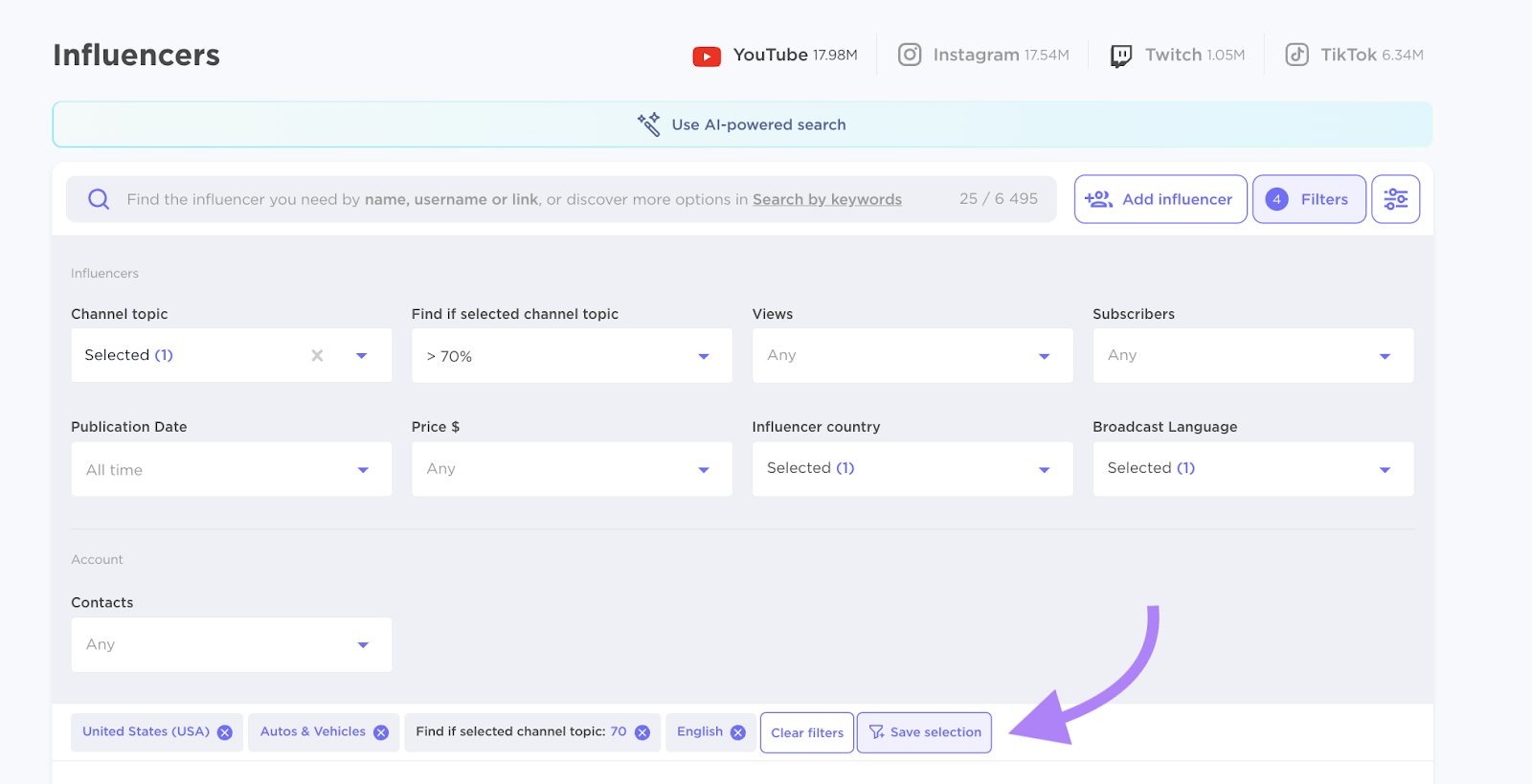
Name your selection, then click “Save.”

Scroll down to see influencers who match your criteria. Click the YouTube logo on the right of each name to see their channel.

Influencer Analytics shows the following influencer metrics:
- Subscriber or follower count
- Number of views
- Channel quality score
- Language
- Price
- Date of last video
Choose the YouTubers you prefer and click “Add to lists.”

Create a new list, name it, and include a short description for team members. Click “Save” then “Done” to confirm.

Access your lists by clicking on the “Lists” tab.
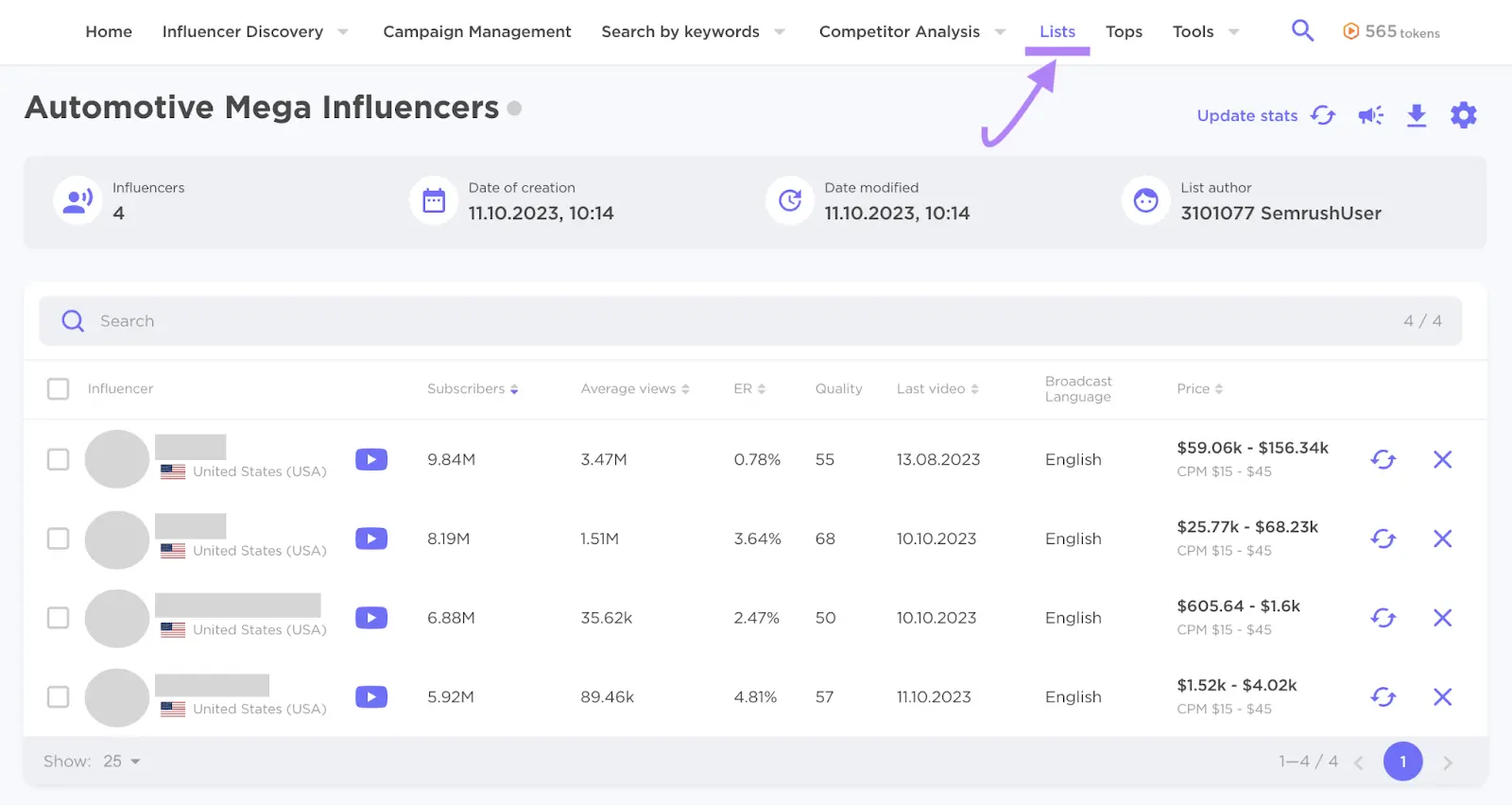
Influencer Analytics also works for TikTok and Twitch.
Audience Intelligence
The Audience Intelligence app examines your social followers and lists other accounts they follow. This helps you find influencers most relevant to your audience.
To see a list of influencers, click on your report in “My Reports.” Then select the “Top Influencer” section.
You'll also see the following information about those accounts:
- Biography: Account bio or summary
- Affinity: How much the account resonates with your audience (based on interactions)
- Uniqueness: How niche the account’s followers are
- Reach: Estimated number of people reached per post on X (formerly Twitter)
- Social Media: Other platforms the account is on

Use this information to find influencers who best match your brand and resonate with your target market.
2. Use Branded Hashtags to Find Relevant Creators
Search your branded hashtags on any social platform to see posts mentioning your brand.
For example, searching #semrush on LinkedIn shows posts that mention Semrush.

Click on “People who talk about #semrush” to see accounts that mention Semrush along with their follower counts.

Apply the same approach on other platforms. For example, searching for #semrush on Instagram reveals posts that use the hashtag.

Look for creators who post about you and fit your business goals. Pro tip: Follow your branded hashtags to see new content in your newsfeed.
3. Search Through Industry Relevant Hashtags
Find influencers by checking posts with industry-specific hashtags.
First, you need to know which hashtags work well in your niche.
Go to Social Tracker.
Choose a platform, such as “Instagram,” then click on the “Hashtags” tab.

You’ll see hashtags that other accounts in your niche use. Go back to Instagram to find creators who used these hashtags.

Find an influencer that aligns with your brand, then check whether the influencer follows your company’s page or your competitors.
Look through their posts for signs that they’re open to collaborating with brands like yours. For example, posts with hashtags like #ad or #sponsored can indicate paid partnerships.

4. Search Through Google
Use Google search operators to find brand mentions.
(Google search operators are commands you can use to find specific information.)
One simple command is:
brand name -yourwebsite.comThis command shows brand mentions outside your own site.
For example:

Go through each post and look for influencers who created content about your brand.
Find more recent posts, which can indicate active influencers, by using the “Tools” button to narrow your search by time (e.g., “Past week”).

Check websites that frequently mention your brand. Look for links to their social accounts. Those site owners could be potential influencers, too.
5. Monitor Brand Mentions
Websites or influencers that mention you positively already understand your brand’s value, so they may be ideal partners for a collaboration.
You can track brand mentions with tools like Semrush’s Brand Monitoring tool, Google Alerts, and Backlink Analytics.
Let’s see how to set them up.
Get Alerts Through the Brand Monitoring Tool
Log in to your Semrush account.
In the “App Center” menu, select “Brand Monitoring.”

Click “Get started.”

Choose “Brand” from the drop-down menu to create a query.

Enter your brand’s name.

Scroll down to see a preview of the mentions.
Click “Create query.”

You’ll now see a list of your brand’s mentions across online publications and social media.
Each mention includes a sentiment label so you can quickly identify positive feedback.

As new mentions appear, you’ll see them here.
You can also set up daily or weekly email alerts.
Click on the “Email notifications” tab.
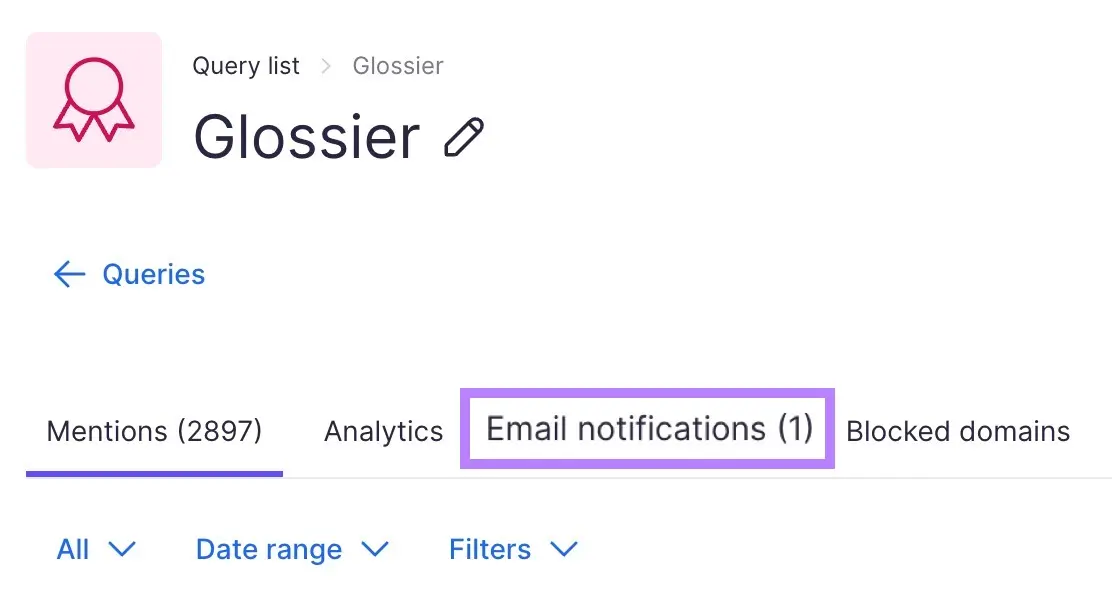
Click “Set up email notifications.”

For example, if you want a daily alert with positive mentions, choose “Daily digest.”

Name your alert.

Specify where to receive the email. Click “More filters.”

Click “Add filter.”

Select “Article sentiment.”

Choose “positive” and click “Select.”

Then, save your alert.

You’ll now receive daily alerts about positive brand mentions. Contact these creators to discuss potential collaborations.
Set Up Google Alerts
Go to Google Alerts.
Enter your brand’s name.
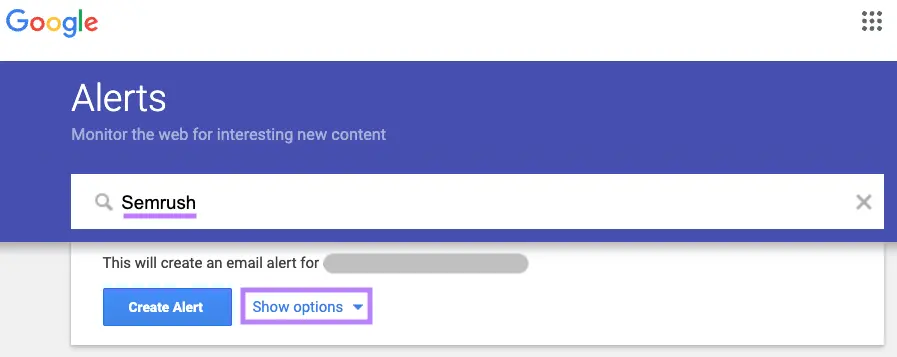
Click “Show options” to personalize your alert frequency, sources, language, region, and delivery method.

You’ll receive alerts as they happen, daily or weekly.
Here’s an example:

Find Creators Who Link to You with Backlink Analytics
Creators who link to your site may already appreciate your brand.
That can lead to potential partnerships.
To find those creators, go to Backlink Analytics.
Then, enter your domain name.

Click on the “Backlinks” tab.

Scroll down to the “Backlinks” section.

In the “Link placement” section, select “Content.”
By selecting this option, you’ll see who’s linking to you from their content.

Check who links to you from their content.
In the example below, a blogger links to a job market website in an article about where to get paid online writing jobs:

Look into the creator more to see if a partnership is viable.
In this case, the blogger is a freelance content creator with a following on YouTube and Medium.
This means they may have enough reach to be an ideal candidate for a partnership.

Because the blogger already knows about the job marketplace, they might be open to a collaboration.
Contact them to see if they’re open to becoming partners and start nurturing that relationship.
6. Do Keyword Research
Keyword research helps you find keywords that potential visitors use when searching for your niche.
This process can also help you identify active influencers.
When you know which keywords are popular, you can see who ranks for them. Those creators might have a large, engaged audience.
Start your research by identifying popular keywords in your niche.
Let’s say you’re a travel company.
First, open the Keyword Magic Tool.
Enter a relevant but broad keyword like “visit spain.”
Click “Search.”

You’ll get a list of relevant keywords sorted by popularity.

Choose a keyword to explore.
For example, “best places to visit in spain.”
Clicking it will take you to Keyword Overview.

Scroll to the “SERP Analysis” section.

Look through the results for individual bloggers and creators.
Click on a website you want to analyze.

The site we selected is an individual creator’s blog. They’re active and recently published an article.

Check if they have social channels. For example, this blog links to their YouTube channel.


Look through YouTube, you’ll notice that this creator publishes content regularly and gets good engagement. That could mean they’re a good fit.
Repeat this process for other keywords related to your niche. You’ll find more influencers who match your interests.
7. Follow Bloggers, Podcasters, and Other Creators
By following creators, you see what kind of content they publish and who they partner with.
There are many benefits to this approach:
- You can engage with their posts and put your brand on their radar
- You can get familiar with the creator’s style and capabilities
- You’ll know what they create and how they engage their audience
This knowledge helps if you decide to work with an influencer on a campaign.
Watching influencers’ collaborations also helps you discover new influencers similar to those you already like.
Kickstart Your First Influencer Campaign with Influencer Analytics
After identifying the right influencers for your project, reach out and start collaborating.
Use Influencer Analytics’ Campaign Management to track all your campaigns.
Monitor results, costs, and performance in real time.
This approach helps you stay organized and measure your success.
